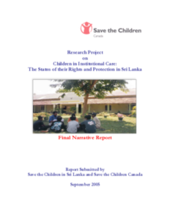Principal findings of study revealed that institutionalization is becoming an option for families in difficult circumstances in the absence of alternative forms of care (for a summary of the key findings, click here). While government policies explicitly state that poverty should not be an admission criterion, 50% of children in voluntary institutions were there for poverty. Moreover, 80% of children in non-state institutions (generally termed “orphanages”) had at least one living parent.
While parents and guardians institutionalize children to provide them with material comforts, children consistently highlighted their need for emotional care. Children spoke out against the lack of privacy, integrity, identity and the absence of avenues of self-expression within institutions, things that are often impossible within the regimented environment of institutions. Data is also provided on the unacceptable standard of basic material facilities in institutions.
It was also found that stipulated administrative structures for the monitoring of institutions, as well as those set in place to minimize institutionalization through close work with families were not operating effectively with many overlaps of duties, ineffective administration, and even rivalries among Departments and other bodies working on childcare.

